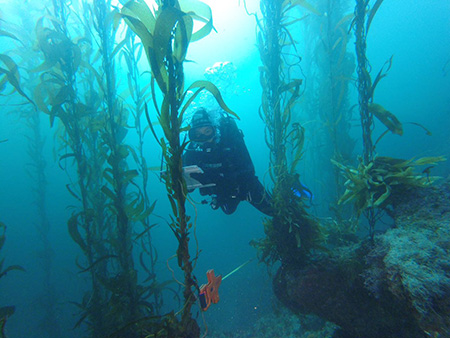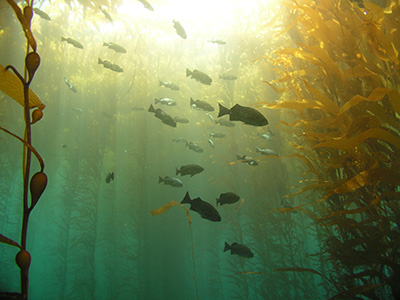In a sweeping display of the power of community-based science to capture data spanning the entire West Coast of North America, a team of scientists and countless volunteers from 14 different organizations joined forces to document the northward migration of kelp forests due to warming waters.
“This is a rare instance when so many have collaborated from Alaska to Mexico to describe how kelp forest ecosystems are being influenced by climate change and how differences among regions of the coast can help us identify where communities and fisheries are most likely to be impacted,” said Mark Carr, professor and chair of ecology and evolutionary biology at UC Santa Cruz.
Carr is a coauthor of the study, published September 9 in Global Change Biology. Participating partners include the University of Alaska, UC Santa Cruz, Reef Check California, Stanford University, San Diego State University, Monterey Bay Aquarium Research Institute, NOAA, and Moss Landing Marine Laboratories in the United States, and Comunidad y Biodiversidad A.C., Universidad Autónoma de Baja California, and fishing communities in Mexico.
Productive ecosystems
Kelp forests are among the most productive and species-rich marine ecosystems in the world. Canopy-forming kelps declined in abundance across the entire study region, but declines were highest in the southernmost portion of the range and in the Northern California ecoregion. Temperate kelp forest ecosystems appear especially vulnerable to marine heatwaves such as the anomalous “warm blob” that appeared in 2014-16.
The results suggest that coastal communities that are dependent on kelp forests will be more impacted in the southern portion of the California Current region, highlighting the urgency of implementing adaptive strategies to sustain livelihoods and ensure food security. The study also highlights the importance of monitoring programs that span an entire ecosystem's range.
“Thanks to a standard monitoring program that spans oceans, years, and many collaborative efforts, we could look at an entire system and gain unique insights. If we had studied just individual areas, we never would’ve been able to draw the same conclusions about how kelp forests are changing,” said senior author Brock Woodson of the University of Georgia.
The researchers hope that this project can serve as a model for how to harness the power of cooperation and volunteer-driven data.
PISCO
The project owes much of its success to the Partnership for the Interdisciplinary Studies of Coastal Oceans (PISCO), a collaboration involving UC Santa Cruz and other universities, which developed the initial monitoring program in California and Oregon in 1999. Reef Check of California, Comunidad y Biodiversidad, and MexCal expanded the PISCO monitoring protocols through citizen science programs. By using similar monitoring guidelines across different programs and groups, the project was able to compare their results to develop a picture of what was happening to kelp forests in different regions.
“It shows the critical value of large-scale, long-term monitoring studies, like the PISCO program here at UCSC and collaborating universities, for providing this information for academics, managers, and policy makers,” Carr said.
Each region had a different type of volunteer divers collecting the information—from undergraduate students and tourist divers in California to women from fishing communities at Isla Natividad in Mexico, known as “Las Sirenas del Mar,” who were trained as divers and have been active participants in the underwater community-based monitoring program.
The volunteers across programs used “belt transects,” a method used to measure distances underwater and visually collect data about the numbers of fish, macroinvertebrates, sponges, algae, and kelp species spotted while diving within the kelp forests.
The changes they helped document could wreak ecological and economic havoc on the communities—both marine and human—that depend on the kelp to survive.
“Think about what would happen if you took the trees out of a forest: it’d be a meadow. There might still be life there, but it wouldn’t look anything like the ecosystem that lived in the forest. Kelp are the trees of the oceanic forest,” Woodson explained.
Lead author Rodrigo Beas from Universidad Autónoma de Baja California, said kelp forests are as complex and productive as tropical rain forests. “It’s an incredible world down there,” Beas said. “Like being in a forest, except that you’re able to fly up into the canopy to see all the life happening at different levels among the trees. Sometimes it can get very dark and moody. It’s beautiful.”
Ocean-wide trend
By analyzing the data from each separate group and area as a whole, the researchers were able to clearly see an ocean-wide trend: edges of the distribution are more sensitive and kelp is migrating northward. But the researchers also noticed that as the kelp migrates, only the species that eat it directly appear to migrate with it. This leaves a broken food web behind.
Senior author Fiorenza Micheli at Stanford University stressed the need to ramp up action. “We documented major, region-wide changes in these productive coastal ecosystems in response to recent heat waves,” Micheli said. “Impacts are greatest in the northern and southern portions of this region, highlighting the urgency of protecting these vital ecosystems, sustaining livelihoods, and ensuring food security for coastal communities.”
Coauthor Jorge Torre at Comunidad y Biodiversidad in Mexico added, “This is an excellent example of collaboration between researchers, communities, and civil society organizations in the United States and Mexico to understand how climate change will impact the kelp forest and therefore fisheries in coastal communities for the next 30 years. This can help us to start making the needed changes so the coastal communities can adapt and maintain ecosystem resilience.”




